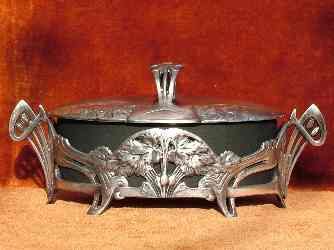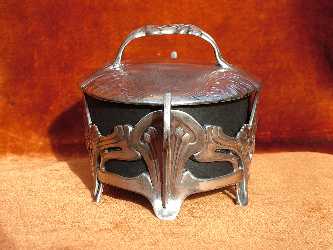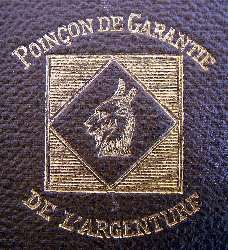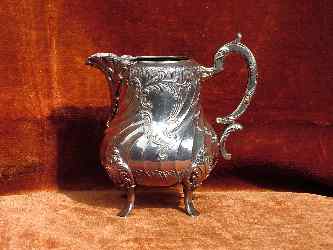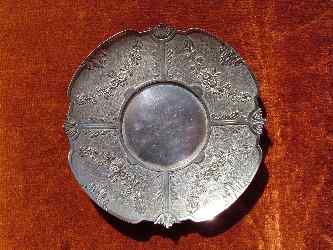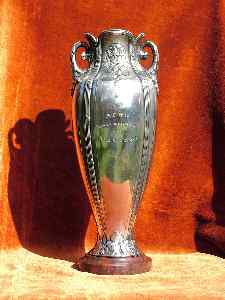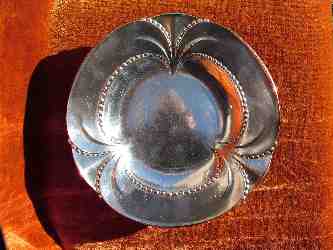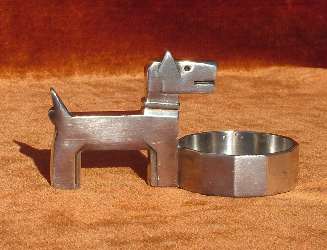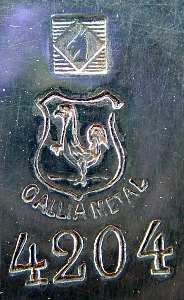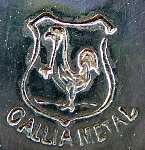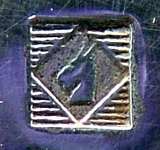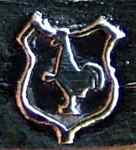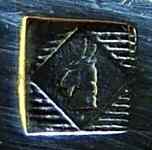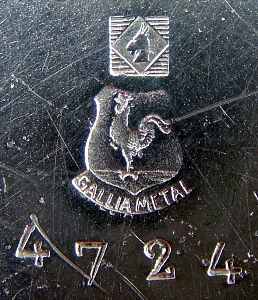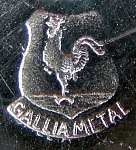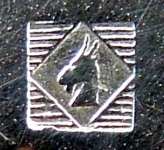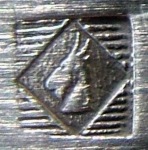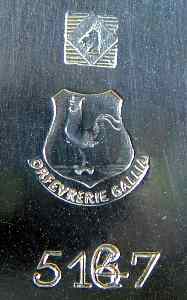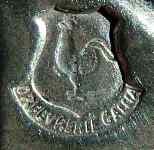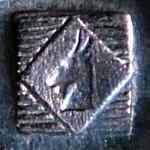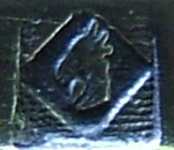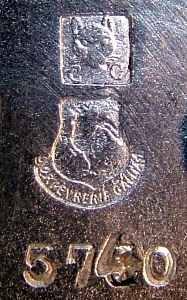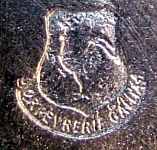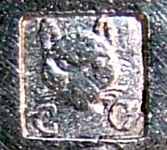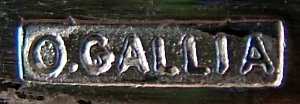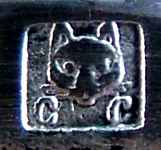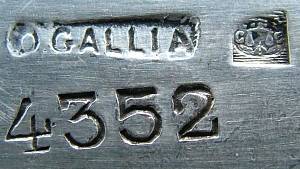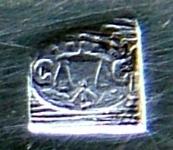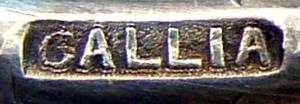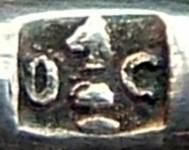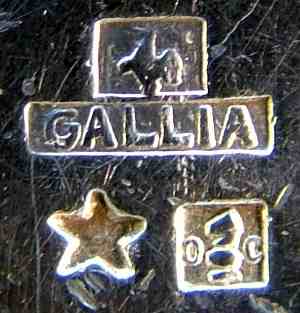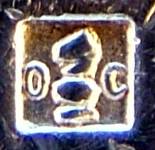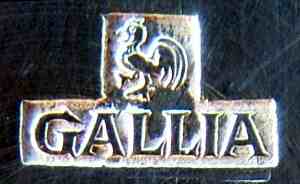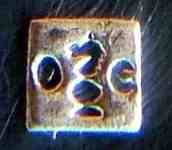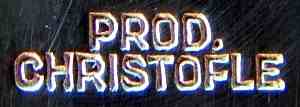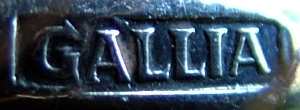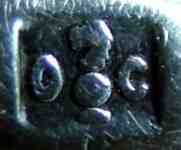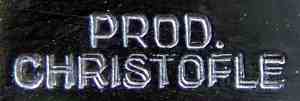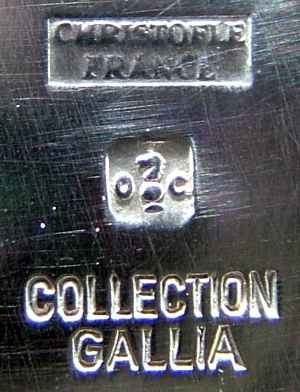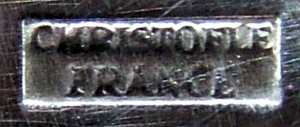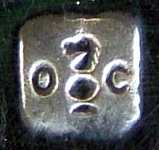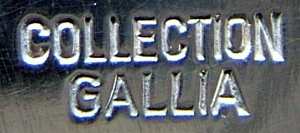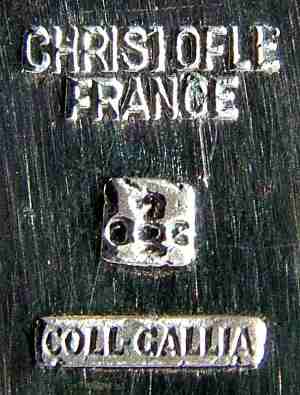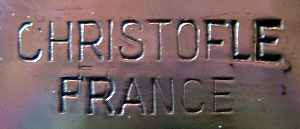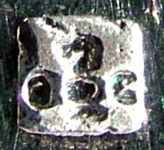A SMALL COLLECTION OF ANTIQUE SILVER |
| an article of David N. Nikogosyan for ASCAS - Association of Small Collectors of Antique Silver |

|
(click on photos to enlarge image)MARKS OF EUROPEAN SILVER PLATE:
|
|
A silver-plated butter dish made from Gallia metal between 1900 and 1908. Model 4369 |
The literature information about Gallia is scarce and often
misleading. As an example, I can mention the article "Christofle:
Marks & History" on the famous web page "Online Encyclopedia of
Silver Marks, Hallmarks and Makers' Marks", where the marks for
Christofle silver-plated Alpacca-based hollow ware,
silver-plated Alpacca-based cutlery and silver-plated
Gallia-based items are mixed together and their dating is often
incorrect. It should be noted that Christofle used for the
Alpacca alloy its own trade mark Métal Blanc (White Metal). The
author of the above-mentioned article (under the pen-name
"2209patrick") wrote that in November 2007 he contacted the
curator of the Musée (Museum) Bouilhet-Christofle in Paris about
the precise dating of some marks and is still waiting for an
answer. This Museum was closed in November 2008 and that
probably was the reason why this web page was never updated.
The first Gallia products were proposed at the end of the XIX.
century by Manufacture de L'Alfénide (Alfenide Foundry, where
Alfenide is simply another brand name for Alpaca or Neusilber), which was belonged to
Christofle since 1888. However, rather than integrating this
acquisition, Christofle allowed it to continue trading under its
own brand as a separate entity. An experienced French goldsmith,
Félix Chéron, was invited to manage the Alfenide factory. Later
he was commissioned to create a new line of cheap tin-based
silver-plated products. The idea was that such a new enterprise
was rather risky for Christofle, who at that time dominated on
the French market of luxury silver-plated products, and it was
decided to introduce the new product under the name of Alfenide.
Therefore, on all newly-produced Gallia items the
Alfenide mark for silver-plating, a profile of a goat inside a
rhombus in a square box, was used. However, once the production
proved to be successful, the Alfenide mark on Gallia objects
disappeared and instead the Christofle mark for silver-plating
was used.
|
A mark for silver-plating, taken from the cover of the catalogue, issued by Manufacture de L'Alfénide in 1891. Interestingly, the design of this mark for silver-plating was used later by WMF for the construction of its famous "ostrich" mark. |
Gallia is the brand name of the copper-tin
alloy, which had been patented by Félix Chéron as early as in 1896.
The exact chemical
content of this alloy is unknown, but it probably contained also
antimony and bismuth. The items made of this alloy could be
produced directly by casting and used for the creation of more
sophisticated relief or more sculptural forms than those based
on Alpacca. Using electroplating, it was possible to cover this
alloy with silver; however, the quality of a silver coating put
on Gallia was lower than that put on Alpacca (Métal Blanc). Félix
Chéron immediately used this newly invented alloy for the
production of a small series of highly decorative items, often
made by distinguished artists and designers. The main purpose of
the Gallia line was to satisfy the market with cheaper products
and simultaneously to follow the current art tendencies. It is
remarkable that nowadays on the world antiques market these
"cheap" silver plate items are sold at 3-10 times higher prices
than "luxury" Christofle products of the same period. The
production continued for seventy years, though the artistic
quality of the Gallia items had declined significantly by 1940.
In 1902, Félix Chéron retired and the position at the head of
Alfénide/Gallia was filled by Henri Harleux, an engineer from
the Ecole Centrale de Paris. He continued the policy of Gallia
brand development. In 1916, under a major reorganization of
Christofle, Harleux established a workshop for Gallia production
in the Christofle factory at Saint-Denis, north of Paris. This
was an independent unit under Harleux's direction, which did not
have to report to the Saint-Denis management. This unit survived
until 1933, when Gallia totally lost its autonomy inside
Christofle.
It should be noted, that the name of Gallia alloy looks similar
to the old Latin name of the France province in the Roman Empire
(Gallia or Gaulle in French). According to the information found
on the Internet, the name GALLIA can mean simply the
abbreviation of "GALvanoplastie alLIAge" (electroplating alloy).
In any case, the marks for Gallia metal items used in the first
thirty years of production were based on the profile of the
famous "coq gaullois" (Gallic cock).
As it is well known, each silver-plated Alpacca-based hollowware
Christofle item, produced in 1863-1928, had its own ordinal
number, running from 1 up to 3000000. On the contrary, the
silver-plated products, based on Gallia metal, had no ordinal
number, but instead during 1900-1935 were obligatorily marked by
the model number. From the beginning, these model numbers were
running from about 4100 until about 6100 (I have in my
collection pieces with model numbers from 4113 to 6098). Later,
at the end of the twenties a new numeration was started, from
about 0100 to at least 0462. So, if you come across a Gallia
item with the model number say 1200 or 12000, you can be sure
that it is a fake! After 1935, the model number mark was not
obligatory any more and soon it disappeared completely.
|
Some Gallia items from my collection: first row: (left) a creamer, model 4204, made in 1900-1908; (right) a dish, model 4724, made in 1900-1908; second row: (left) an Art Nouveau flower vase, model 5740, made in 1916-1921; (right) an Art Deco trophy vase, standing on a marble basement, model 5451, made c.1928; third row: (left) a fruit-dish, model 5791, made in 1921-1930; (right) a salt cellar, model 5988, made in 1930-1935. |
I have in my collection about four dozen of silver-plated Gallia items, their marks are presented below. Though some Gallia silver plate marks were described earlier (see the references given below), I am happy to present here a full and systematized description that, to the best of my knowledge, has never been done before.
Marks for items with "GALLIA METAL" inscription (c.1900-1908)
I am indebted to Professor Marc de Ferrière le Vayer for giving me the opportunity to study his unpublished paper on the Gallia brand history and for numerous discussions that followed. I also would like to thank Giorgio Busetto for his continuous cooperation and Jayne Dye for her careful reading of my manuscript.
LITERATURE
1. Tarif Général, Manufacture de L'Alfénide, F. Chéron & Cie, Paris, 1891. [In French].
2. Tarif Special Orfévrerie Argentée & Dorée en "Gallia Metal" Etain Durci, Marque & Modéles Déposés, Manufacture de L'Alfénide, 66, rue des Marais, Paris, 1900, pp.1-24. [In French].
3. Tarif Special d'Orfèvrerie d'Etain Argenté et Doré marque GALLIA METAL, Paris, 1904, pp.1-24. [In French].
4. Orfèvrerie Gallia, Manufacture de L'Alfénide, 66, rue des Marais, Paris, circa 1910, pp.1-62. [In French].
5. Orfèvrerie Gallia, Manufacture de L'Alfénide, 66, rue des Marais, Paris, 1921, pp.1-131. [In French].
6. Orfèvrerie Gallia, Catalogue Général, 1929, pp.1-79. [In French]
7. Marc de Ferrière, Christofle: 150 ans d'Art et de Rève. Dossier de l'Art, No.2, pp.3-73 (1991), [in French].
8. Marc de Ferrière le Vayer, Histoire de L'Orfévrerie Gallia. [In French]
9. Online Encyclopedia of Silver Marks, Hallmarks and Makers' Marks, http://www.925-1000.com/a_christofle.html
10. David N. Nikogosyan, An unknown mark for silver-plated hollow ware used by Christofle in 1930-1935, http://www.ascasonline.org/articologiugni130.html
Dr. David N. Nikogosyan
- 2013 -
further information and marks CHRISTOFLE, VEUVE CHARLES HALPHEN, GOMBAULT-DESCLERCS & MANUFACTURE DE L'ALFÉNIDE
 www.silvercollection.it |
|
This is a page of A Small Collection of
Antique Silver and Objects of vertu, a 1500 pages richly illustrated website offering all you need to know about
antique silver, sterling silver, silverplate, Sheffield plate, electroplate silver,
silverware, flatware, tea services and tea complements, marks and hallmarks, articles,
books, auction catalogs, famous silversmiths (Tiffany, Gorham, Jensen, Elkington),
history, oddities ... HOME - SITE MAP - SILVER DICTIONARY - COOKIES CONSENT AND PRIVACY OTHER ARTICLES ABOUT: ANTIQUE SILVER SILVER PLATE ENGLISH SILVER FRENCH SILVER |
